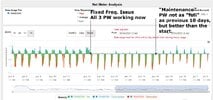Just had a Solar + 3 Powerwall system installed. Have been running off-grid while waiting for PTO. App shows 3 Powerwalls with a state of charge somewhere between 0% and 100%. Walls charge up to 100% during the day; house runs off Powerwalls when there’s no solar production.
After a week or two I got the feeling that the Powerwalls were discharging too quickly. As an example with nice round numbers, let’s say I was running off the Powerwalls for 13.5 hours between sunset and sunrise, and my house used an average of 1kW. So I would have drawn about 13.5kWh from the Powerwalls between when the panels stopped producing and when they restarted.
Since each Powerwall has 13.5kWh of energy, I basically used 1 Powerwall worth of energy overnight. But my app said I was at 50%, not 67% (as you’d expect with 3 Powerwalls). I did similar measurements and calculations over several days and concluded that my system was behaving as if I only had 2 Powerwalls, not 3 (even though the app always said I had 3). All 3 Powerwalls were on and glowing green on the sides. I also reset the Gateway and the Powerwalls multiple times during my testing to make sure that didn’t solve the problem.
I eventually got through to Tesla and had them run a diagnostic. Initially they saw nothing - everything looked fine. I asked them to look again and after more testing, they said something like “oh…it looks like one of your Powerwalls is in permanent standby.” So they confirmed that I had a Powerwall that wasn’t working correctly and opened a “Tier 2 ticket” or some such thing that hopefully someday will lead to the problem being fixed.
So my warning to everyone with multiple Powerwalls is:
There were two other clues that I had a bad Powerwall. The first is that when I turned my Powerwalls off and on with the switch on the side, you could hear relays clicking inside 2 of them, but one was silent.
The second clue is that (labeling my 3 Powerwalls A, B, and C), I could turn off A and B, and C would continue to power the house. I could turn off A and C, and B would continue to power the house. But if I turned off B and C, there was no power.
After a week or two I got the feeling that the Powerwalls were discharging too quickly. As an example with nice round numbers, let’s say I was running off the Powerwalls for 13.5 hours between sunset and sunrise, and my house used an average of 1kW. So I would have drawn about 13.5kWh from the Powerwalls between when the panels stopped producing and when they restarted.
Since each Powerwall has 13.5kWh of energy, I basically used 1 Powerwall worth of energy overnight. But my app said I was at 50%, not 67% (as you’d expect with 3 Powerwalls). I did similar measurements and calculations over several days and concluded that my system was behaving as if I only had 2 Powerwalls, not 3 (even though the app always said I had 3). All 3 Powerwalls were on and glowing green on the sides. I also reset the Gateway and the Powerwalls multiple times during my testing to make sure that didn’t solve the problem.
I eventually got through to Tesla and had them run a diagnostic. Initially they saw nothing - everything looked fine. I asked them to look again and after more testing, they said something like “oh…it looks like one of your Powerwalls is in permanent standby.” So they confirmed that I had a Powerwall that wasn’t working correctly and opened a “Tier 2 ticket” or some such thing that hopefully someday will lead to the problem being fixed.
So my warning to everyone with multiple Powerwalls is:
You could have a completely non-functional Powerwall and the problem will not show up in your app and Tesla might never notice.
So I recommend you do a sanity check (compare kWh usage vs % drained) periodically to make sure you have all the energy storage you paid for.There were two other clues that I had a bad Powerwall. The first is that when I turned my Powerwalls off and on with the switch on the side, you could hear relays clicking inside 2 of them, but one was silent.
The second clue is that (labeling my 3 Powerwalls A, B, and C), I could turn off A and B, and C would continue to power the house. I could turn off A and C, and B would continue to power the house. But if I turned off B and C, there was no power.



